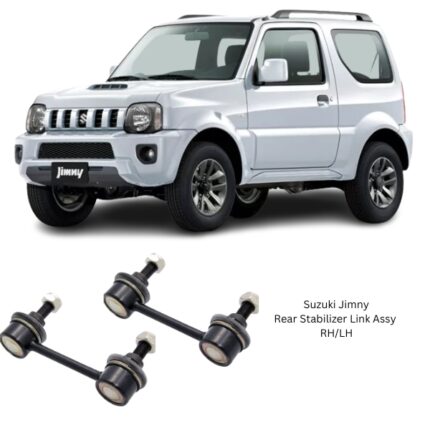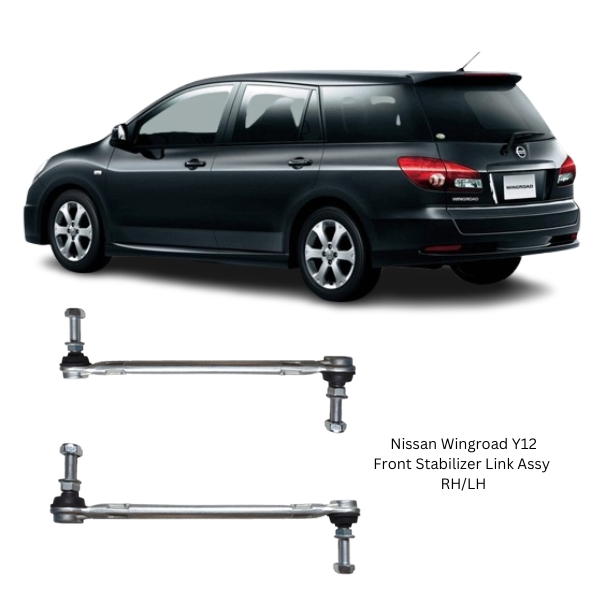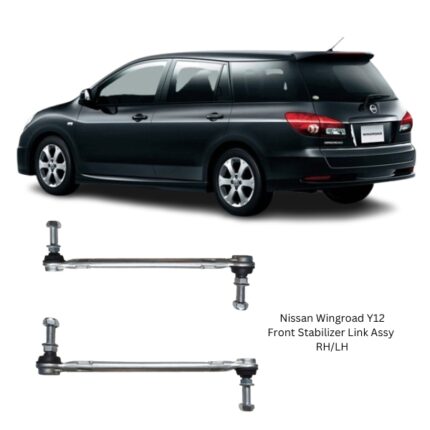Get Nissan Wingroad Y12 Front Stabilizer Link Assy RH/LH 54618-ED000 in Kenya
The Front Stabilizer Link Assembly, covering both the Right-Hand (RH) and Left-Hand (LH) sides, is an essential part of the vehicle’s front suspension system. Its primary function is to connect the front stabilizer bar (anti-roll bar) to the suspension components—typically the strut or lower control arm. Despite its compact size, this component plays a substantial role in vehicle handling, comfort, and safety.
By linking the stabilizer bar to each side of the suspension system, the stabilizer links help reduce body roll during cornering, improve traction, and distribute forces evenly across the front axle. This improves not only driving comfort and control but also reduces wear on tires and other suspension components.
Purpose and Function
The Front Stabilizer Link Assembly is responsible for transferring movement and force between the front suspension and the stabilizer bar. This interaction allows the anti-roll bar to perform its task of stabilizing the vehicle during turns, lane changes, and uneven road conditions.
Key Functions:
-
Reduces Body Roll
During cornering or sharp maneuvers, the stabilizer link transmits movement to the stabilizer bar, which counteracts excessive leaning by distributing force across both front wheels. -
Maintains Suspension Balance
Links both sides of the suspension via the anti-roll bar, helping the wheels move in coordinated motion and maintaining vehicle balance on uneven roads. -
Improves Steering Response
Contributes to better handling by keeping the tires firmly in contact with the road surface during directional changes or sudden movements. -
Promotes Tire Longevity
By limiting uneven weight transfer, it helps prevent abnormal tire wear caused by uncontrolled body sway.
Construction and Design
The Front Stabilizer Link Assembly is designed for durability and precision movement. It is typically comprised of a strong shaft, two jointed ends (ball joints or bushings), protective seals, and hardware for secure attachment to the suspension system.
Main Components:
-
Ball Joints or Bushings
These are located at both ends of the link and allow multi-directional movement while securely connecting the stabilizer bar to the suspension. Ball joints are more commonly used for their superior range of motion and load capacity. -
Link Shaft
This is a rigid metal bar—straight or slightly curved—connecting both ends. Made from high-strength materials, it can endure twisting and tensile forces without deforming. -
Threaded Studs and Locknuts
Used to fasten the link assembly to the stabilizer bar and the suspension component, ensuring a tight and secure fit. -
Dust Boots
Seals made of rubber or thermoplastic that protect the internal joints from dirt, moisture, and corrosion.
Materials:
-
Hardened Steel or Forged Aluminum
Provides durability and strength while remaining lightweight. -
Synthetic Rubber or Polyurethane
Used in boots or bushings for flexibility, resilience, and wear resistance. -
Anti-Corrosive Coatings
Often zinc-plated or phosphate-treated for long-lasting protection against rust, especially in wet or salty conditions.
Performance Advantages
A properly functioning Front Stabilizer Link Assy RH/LH is critical to maintaining driving precision and stability. When intact and installed correctly, this component:
-
Improves Road Holding
Keeps the front tires more planted during cornering and uneven road conditions. -
Enhances Safety
Reduces the likelihood of body roll that can compromise control and stability during evasive maneuvers. -
Promotes Even Suspension Load Distribution
Prevents the over-compression or lifting of one side of the vehicle when driving over potholes or bumps. -
Minimizes Component Wear
Reduces stress on adjacent suspension parts, including shocks, struts, and control arms.
Symptoms of Wear or Failure
Like all suspension components, stabilizer links wear down over time due to regular use, environmental exposure, and road conditions. When they begin to fail, the handling and comfort of the vehicle deteriorate noticeably.
Common Signs Include:
-
Clunking or Rattling Sounds
Especially over rough roads or speed bumps. Caused by loose or worn joints. -
Increased Body Sway
Excessive leaning during cornering or instability during quick directional changes. -
Steering Inconsistencies
Reduced responsiveness or a sense of “looseness” in the steering wheel. -
Uneven or Accelerated Tire Wear
Caused by poor suspension alignment due to a compromised link. -
Visual Wear
Torn dust boots, rust, or a visibly bent shaft are signs of mechanical fatigue.
Installation Overview
Installing or replacing a Front Stabilizer Link Assembly is a relatively straightforward process that requires basic mechanical tools. However, proper alignment and torque settings are essential to ensure optimal performance and longevity.
General Installation Steps:
-
Raise the Vehicle Safely
Use a jack and secure the front of the vehicle with jack stands. -
Remove Front Wheels (if necessary)
Gain full access to the stabilizer bar and suspension mount points. -
Detach Old Link
Loosen and remove the bolts or nuts securing the link to both the sway bar and control arm or strut. -
Inspect Connection Points
Check for rust, wear, or elongation in mounting holes. -
Install New Link
Position the new assembly correctly (RH or LH), secure both ends, and torque all fasteners to manufacturer specifications. -
Road Test
Drive to confirm noise has been eliminated and handling feels stable and responsive.
Tip: For best results, always replace stabilizer links in pairs to maintain balanced suspension performance across both sides.
Maintenance Tips
To extend the life and performance of your Front Stabilizer Link Assembly, regular inspection and timely replacement are important:
-
Visual Inspections
Check for rust, cracked boots, or joint movement during routine servicing. -
Lubrication
Some designs come pre-lubricated and sealed; others may include grease fittings for maintenance. -
Avoid Overloading
Excess vehicle weight or aggressive driving over potholes and speed bumps can reduce link life. -
Replace Other Worn Components
Pair replacements with stabilizer bar bushings or control arms if they show signs of wear.
Importance of Timely Replacement
Delaying the replacement of worn stabilizer links can lead to a decline in vehicle handling, increased wear on other suspension parts, and compromised safety.
Consequences of neglected stabilizer links include:
-
Sway bar misalignment
-
Damage to struts or control arms
-
Inconsistent braking performance
-
Accelerated wear on tires and other joints
Follow us on Facebook for more parts.





Reviews
Clear filtersThere are no reviews yet.